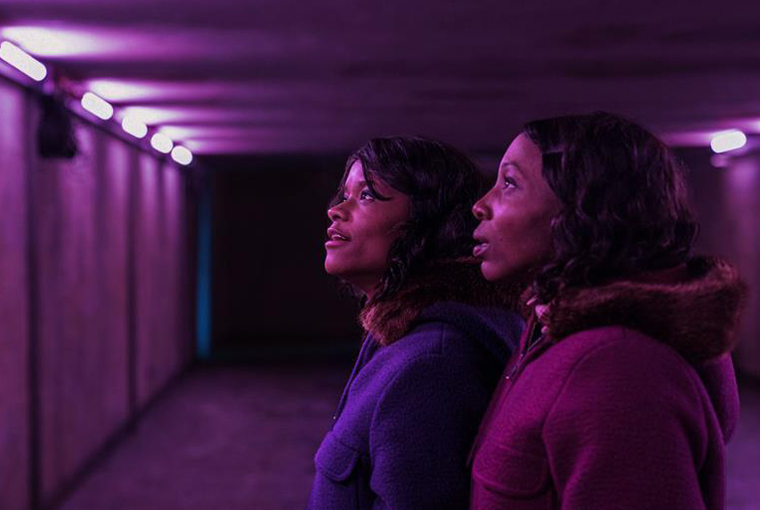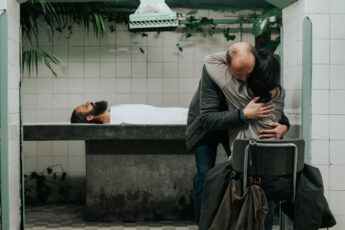“You’ll Never Find Joy If You Want to Be Alone.”
Agnieszka Smoczyńska’s The Silent Twins (2022)
Vol. 126 (Summer 2022) by Jack Page
Originally from Barbados, identical twin sisters June and Jennifer Gibbons find themselves worlds away in the frostbitten Welsh valleys. From a young age their family traded the tropical climate of their home country to find work in the perpetually lusterless town of Haverfordwest. Subjected to racially charged bullying at school, their segregation from society becomes internalized. Choosing only to communicate with each other in private, June and Jennifer shut themselves off from their surroundings, fellow students and even parents. They do not play with friends, participate in class or converse with family at mealtimes, birthdays, or Christmases. Their coping mechanism is, however, misunderstood by teachers and doctors and the film clearly points a finger at the educational and legal systems that failed the two young girls. The Silent Twins is an ingenious blend of magical realism, animation, and fiction film, borrowing from the Gibbons’ diary entries, first-hand encounters, and interviews with social workers to revision the girl’s twisted and tragic narrative.
Smoczyńska’s English-language debut experiments with a variety of formal elements. The camera’s perspective often switches between a shared, fantastical dream world and the actual harsh reality of the Gibbons’ environment. The film begins with a radio show hosted by the twins, featuring T. Rex’s single Hot Love. A playful, psychedelic color scheme – invoking early MTV imagery – is layered over the two girls and their professional-looking mics and tape deck. They chuckle, dancing and ad-libbing over the groovy music, as multi-colored spotlights float across the screen. Their mother knocks on the bedroom door, putting an abrupt end to the pretend disco. The camera zooms out over one twin’s shoulder until the drab interior of the room fills the frame. There is no equipment or sound within the four grey walls. The patter of a light rain shower hangs in the air as the girls sit motionless at their desk.
In this instance, the director’s trickery not only questions the reliability of June and Jennifer’s narration of the film, but it also exposes the sad truth of their psychological condition. At the dinner table, June (Letitia Wright) and Jennifer (Tamara Lawrance) measure every item equally. Each cup must be filled to the same height with milk and every pea on the plate must be eaten one by one. At times of forced social interaction, both girls turn to self-harm, piercing and scratching the skin of their hands by digging in their nails mercilessly and emotionlessly. Nevertheless, June and Jennifer find life in their boundless creativity, penning short stories and devising amateur plays for the soft toys they have built by hand. These distinctive outlets are how they comprehend the world around them, oftentimes blending real-life aspects (love interests, criminal activities) into their fictional storytelling. These scenes allow the audience to interpret the Gibbons’ reality as they do, offering a sensational and suspect kaleidoscope of feelings. As the film actualizes some of their pieces, The Twin Sisters teeters on the experimental, offering the viewer a bombardment of schizophrenic sequences that bleed fact into fiction and the subjective into the objective.
Like with any siblings, a rivalry complicates the twins’ relationship. Jealousy and ambition to publish their co-written stories plagues their once symbiotic nature. In particular, a love interest named Wayne (Jack Bandeira) poses a threat to their sisterhood. Wayne is portrayed as such a stereotypical jock that his entire character arch might just be another example of the sisters’ embellished point of view. After a conventional makeover montage, the twins attempt to romance Wayne. Vying for his attention with a boom box outside of his house, the girls are obliged to smoke, drink, and take drugs with the newfound, extremely sexualized high schooler. Their encounters together could be entirely fabricated, mere material and inspiration for their next novella. That is, until June’s revealing perspective of Jennifer and Wayne making love unfolds. What was once a sensual, slow-motion sequence shot above a convertible laced with roses is quickly uncovered by June’s uncomfortable staring. The background of a hay-filled barn vanishes and the lewd act is witnessed matter-of-factly, in a dank and dimly lit garage, devoid of attraction or titillation for either party.
In court, the Gibbons sisters are tried and convicted for arson and theft. An examiner states they have a “sub-normality… psychopathic illness” and the twins receive a life sentence to a psychiatric hospital. Upon admission to the ward, there is a highly stylized musical number where the nurses and guards perform synchronized swimming choreographies and waltz around the grounds. It’s a cruelly saccharine sequence, so far removed from the twins’ expectations and their harrowing ordeal during the trial. The high-key lighting and upbeat orchestral song widens the gap between the girls and the grim repercussions. It feels like a daydream that they aren’t really invested in either. Smoczyńska’s respectful and insightful handling of two extraordinary real-life sisters is a genre-defying feature that illustrates the strength of sisterly love. In its own limitless imagination, The Silent Twins is a painfully cautionary tale of what can happen when you take away the things we need the most.




Leave a Comment